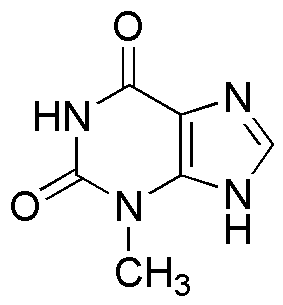2,6-Dihydroxy-3-methylpurine is widely utilized in research focused on:
- Pharmaceutical Development: This compound serves as a crucial intermediate in synthesizing various pharmaceuticals, particularly in the development of antiviral and anticancer agents.
- Biochemical Research: It is used in studies related to purine metabolism, helping researchers understand cellular processes and the effects of purine derivatives on biological systems.
- Genetic Studies: The compound is involved in the synthesis of nucleic acids, making it valuable for genetic engineering and molecular biology applications.
- Diagnostic Applications: 2,6-Dihydroxy-3-methylpurine can be used in diagnostic assays to measure purine levels in biological samples, aiding in the diagnosis of metabolic disorders.
- Food and Beverage Industry: It has potential applications in the formulation of food additives and flavor enhancers, leveraging its properties to improve product quality.
General Information
Properties
Safety and Regulations
Applications
2,6-Dihydroxy-3-methylpurine is widely utilized in research focused on:
- Pharmaceutical Development: This compound serves as a crucial intermediate in synthesizing various pharmaceuticals, particularly in the development of antiviral and anticancer agents.
- Biochemical Research: It is used in studies related to purine metabolism, helping researchers understand cellular processes and the effects of purine derivatives on biological systems.
- Genetic Studies: The compound is involved in the synthesis of nucleic acids, making it valuable for genetic engineering and molecular biology applications.
- Diagnostic Applications: 2,6-Dihydroxy-3-methylpurine can be used in diagnostic assays to measure purine levels in biological samples, aiding in the diagnosis of metabolic disorders.
- Food and Beverage Industry: It has potential applications in the formulation of food additives and flavor enhancers, leveraging its properties to improve product quality.
Documents
Safety Data Sheets (SDS)
The SDS provides comprehensive safety information on handling, storage, and disposal of the product.
Product Specification (PS)
The PS provides a comprehensive breakdown of the product’s properties, including chemical composition, physical state, purity, and storage requirements. It also details acceptable quality ranges and the product's intended applications.
Certificates of Analysis (COA)
Search for Certificates of Analysis (COA) by entering the products Lot Number. Lot and Batch Numbers can be found on a product’s label following the words ‘Lot’ or ‘Batch’.
Numéro de catalogue
Numéro de lot/série
Certificates Of Origin (COO)
This COO confirms the country where the product was manufactured, and also details the materials and components used in it and whether it is derived from natural, synthetic, or other specific sources. This certificate may be required for customs, trade, and regulatory compliance.
Numéro de catalogue
Numéro de lot/série
Safety Data Sheets (SDS)
The SDS provides comprehensive safety information on handling, storage, and disposal of the product.
DownloadProduct Specification (PS)
The PS provides a comprehensive breakdown of the product’s properties, including chemical composition, physical state, purity, and storage requirements. It also details acceptable quality ranges and the product's intended applications.
DownloadCertificates of Analysis (COA)
Search for Certificates of Analysis (COA) by entering the products Lot Number. Lot and Batch Numbers can be found on a product’s label following the words ‘Lot’ or ‘Batch’.
Numéro de catalogue
Numéro de lot/série
Certificates Of Origin (COO)
This COO confirms the country where the product was manufactured, and also details the materials and components used in it and whether it is derived from natural, synthetic, or other specific sources. This certificate may be required for customs, trade, and regulatory compliance.


